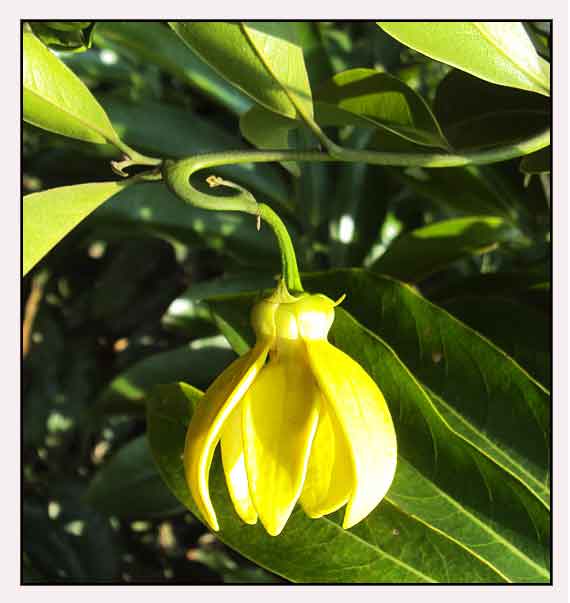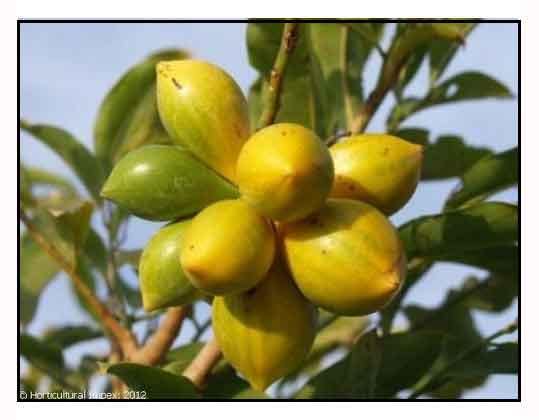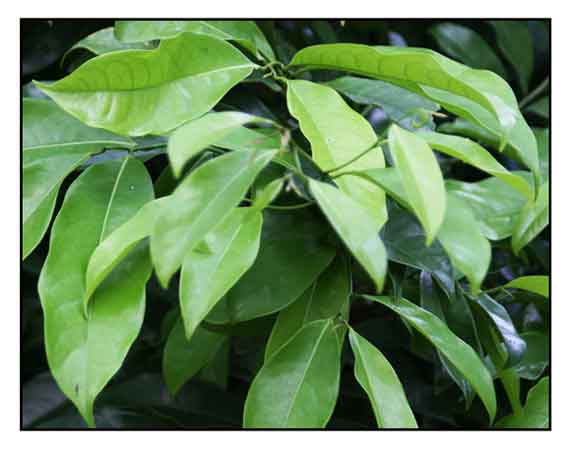 Gen info Gen info
Ilang-ilang is a
common name shared by (1) Ilang-ilang gubat, Desmos
cochinchinensis (2)
Ilang-ilang, Cananga
odorata, and (3) Ilang-ilang vine, Arbotrys hexapetalus.
Botany
Artabotrys hexapetalus is a climbing vine or scandent shrub that can reach up to 6 m tall. The plant is a shrub when young, becoming a climber when it attains a height of about 2 meters. Young twigs are densely appressed, brown and hairy, while old twigs have many obtuse thorny branches, 1.5-6 cm long. Leaves are 5 to 25 cm by 2.5 to 8 cm, wedge-shaped at the base, acute at the apex, short, acuminate with 0.4 to 0.8 cm long petiole. Flower is solitary or in pairs on a straight peduncle, later thickened and recurved. Sepals are ovate triangular, about 5 mm long and hairy outside. Outer petals are 3.7 to 4.5 cm by 0.9 to 1.6 cm; inner petals 3.2-4.2 cm by 0.9 to 1.2 cm, green turning bright yellow and with 20-30 carpels. Carpels are monocarp, obovoid, mucronate, 3.5 to 5 cm long, yellow, and a pleasant fruity fragrance. (11)
Distribution
- Indigenous in southern India and Sri Lanka, later introduced throughout the Old World tropics.
- Commonly cultivated in southern china, Indo-china, the Philippines, and Java.
(11)
 Constituents Constituents
- Study of leaves yielded two new flavonol glycosides, artabotryside A (1) and artabotryside-B (2) along with three known flavonoids, taxifolin (3), 7-O-glucoluteolin (4), apigenin-7-O-apiosyl(1-->2) glycoside (5), and two organic acids, succinic (6) and fumaric aid(7). (3)
- Dried extracts of Arbotrys hexapetalus yielded quercetin in the range of 0.35%-4.26% (w/w) and apigenin 0.64%-8.46% (w/w). (4)
- Study of hexane extract of leaves isolated four aliphatic compounds, namely: monotricont-6-ene-25-ol (1), monotriacontan-13-ol (2), heptylundecyl-5-enoate (3), and butanone-3-undecylicosanoate (4).
(7)
- Study of roots isolated seven pairs of sesquiterpenes (1a/1b-7a/7b), a new peroxybridge sesquiterpene (8), and a new peroxy-bridge norsesquiterpene (9), together with five known compounds. (see study below)
(8)
- Study of seeds isolated eight compounds, identified as four neolignans, isoamericanin A (1), isoamericanol A (2), americanin B (3), and artabotrycinol (4), a semiterpenoid, (R)-artabotriol (5), along with palmitic acid (6), beta-sitosterol (7), and daucosterol (8).
(9)
- Flower yields a light, watery, transparent, sweet, and delicate pale yellow essential oil. The EO contains benzyl acetate, benzyl benzoate, linalool, caryophyllene, geranyl acetate, methyl benzoate, p-cresyl methyl ester, safrole, etc.
- GC and GC/MS stnalysis of A. hexapetalus flower essential oil yielded 26 components of the oil including sesquiterpene hydrocarbons (33.3% of the oil) and oxygenated sesquiterpenoids (47.7%).
Major components were identified as ß-caryophyllene (11.4%) and caryophyllene oxide (31.5%).
(15)
- Study of leaves yielded two novel flavonol glycosides named arapetaloside A and B, along with three known flavonoids, taxifolin, apigenin-7-O-apiosyl (1 fwdarw 2) glucoside ad glucoluteolin.
(22)
Properties
- Considered antidepressant, mood elevator, antiseborrheic, antiseptic, aphrodisiac, hypotensive, hair revitalizer.
- Studies have suggested anthelmintic, cytotoxic, antileishmanial, antioxidant, anticancer, radical scavenging, antifertility, antiviral properties.
Parts used
Fruits, roots, leaves, bark, essential oil.
Uses
Folkloric
- In Chinese folk medicine, root and fruits used in treatment of malaria and scrofula, respectively. (3)
- Tribal communities of India use the plant for treatment of cholera.and worm infestation. (5)
Others
- Essential oil: Flowers yield an essential oil used in perfumes, deodorants, beauty soaps, shampoos, skin and hair lotions and creams. (4)
 Studies Studies
• Antileishmanic Activity / Apigenin and Quercetin: Study evaluated the antileishmanic effects of different extracts of A. hexapetalus against Leishmania donovani. Dried extracts yielded quercetin in the range of 0.35%-4.26% (w/w) and apigenin 0.64%-8.46%. Cytotoxicity assay of extracts over promastigotes showed the petroleum ether extract to be most cytotoxic with IC50 10.28 ± 1.06 µg/mL. Results showed the plant is effective against L. donovani in vitro. (4)
• Antidiarrheal / Anthelmintic Activity: Study of the aromatic plant in experimental models showed antidiarrheal and anthelmintic effects. (5)
• Antimicrobial against Storage Fungi and Aflatoxin B1 Secretion: / Essential Oil: Study evaluated the essential oil for antifungal activity against some storage fungi contamination of food stuffs. Results showed EO MIC of 750 µL/L against Aspergillus flavus, superior to prevalent synthetic fungicides. The EO exhibited broad fungitoxic spectrum against 14 different storage fungi. Also, the EO showed significant efficacy in arresting aflatoxin B1 secretion by the toxigenic strain of A. flavus. (6)
• Antiviral / Cytotoxic / Roots: Study of roots isolated seven pairs of sesquiterpenes (1a/1b-7a/7b), a new peroxybridge sesquiterpene (8), and a new peroxy-bridge norsesquiterpene (9), together with five known compounds. Compounds 1a, 1b, 12a-12d, and 14 sowed moderate antiviral activity against Coxsackie virus B3 with IC50s of 6.41-33.33 µM and S1 values >2.1. Compounds 5b, 8, and 12a exhibited weak activity against influenza virus A H3N2 with IC50s range from 19.24 to 33.33 µM and S1 values > 3.0. Compound 12c exhibited selective cytotoxicity against A2780 cell line with IC50 of 8.30 µM, while compound 12d showed potent activity against HCT-116, HepG2, and A2780 cell lines with IC50 of 3.24, 3.23, and 3.14 µM, respectively. (8)
• Copper Nanoparticles / Antibacterial: Study reports on the green synthesis of CuO nanoparticles using Artobotrys hexapetalus and Bambusa vulgaris plant extracts as reducing agents. The antibacterial activity of both prepared CuO nanoparticles was evaluated against gram-negative E. coli pathogen. (10)
• Antimicrobial / Antioxidant / Anticancer / Leaves: Study revealed antimicrobial, antioxidant and anticancer potential by invitro assay of Artabotrys hexapetalus leaves. Compared to other solvent extracts, the methanol extract yielded the higher phenolic content (49.15 µg/mg), flavonoid content (49.15 µg/mg) and potential antioxidant capacity (IC50 of 10.15 ± 0.85 µg/mg). Trisaccharide, n-hexadecanoic acid was isolated. The trisaccharide and partially separated fractions yielded higher antioxidant, anticancer (MCF-7) and antimicrobial activity. Results suggest potential for a new biological agent from A. hexapetalus leaves. (12)
• Preparation of Essential Oil Microcapsule / Antibacterial / Invention: Invention relates to the preparation method and application of Artabotrys hexapetalus essential oil microcapsule The obtained A. hexapetalus EO is in powder form, relatively good in water solubility and stability, high in embedding rate, and slow to release, with significant antibacterial activity, with potential application in chemicals and medicines. (14)
• Radical Scavenging Activity / Phenolic Content / Leaves: Study of leaf extract of A. hexapetalus showed 83.17% DPPH scavenging activity. Total phenol content was 123.138 µgGAE/µg and flavonoid content of 279.640 µgRutin/µg. (16)
• Absence of Anthelmintic Activity / Leaves: Study of a hydoalcoholic extract of Artabotrys hexapetalus leaves did not show anthelmintic activity against African adult earthworm Eudrilus eugeniae. (17)
• Novel Lipid Constituents / Antimicrobial / Leaves: Study of unsaponifiable matter extract from leaves of A. odoratissimus isolated novel lipds by using n-hexane. Two known compounds, one new carboxyester, 1-carboxy-heneicosane pentadecanoate, and two monoesters, hexyl pentaicosanoate and pentyl pentaicosanoate, were identified. The isolated compounds showed variable antimicrobial activity (18)
• Antibacterial / Cytotoxicity / Essential Oil: Study evaluated the chemical constituents and bioactivity of essential oil from A. hexapetalus. GC-MS analysis detected 68 chromatographic peaks and identified 53 compounds. The EO showed inhibitory activity against S. aureus, E. coli, B. subtilis and exhibited higher activity to restrain liver cancer cells (BEL-7402) with IC50s of 12.07 mg/L. (19)
• Anthelmintic / Cytotoxicity / Bark: Study of a methanolic bark extract of A. hexapetalus showed in-vitro anthelmintic activity using Pheretima posthuma and cytotoxic activity using brine shrimp lethality bioassay.. (20)
• Sesquiterpenoids / Cytotoxicity against Cancer Cell Lines / Roots: Study of roots isolated artaboterpenoids A and B (1 and 2), two novel bisabolene-derived sesquiterpenoids. Compound 2a exhibited cytotoxic effects against HCT-116, HepG2, A2780, NCI-H1650, and BGC-823 cell lines with IC50s of 1.38 to 8.19 µM. (21)
• Antifertility / Leaves: Study evaluated various extracts of A. odoratisimus and C. guianensis for antifertility activity in adult female rats measuring effect on duration of various stages of estrus cycle and number of transplantation sites in pregnant rats. The ethanol and water extracts of A. odoratissimus leaves showed anti-implantation effect. The disturbance in implantation may be due to interference in the receptive stage of the uteri and endometrial sensitivity for decidualisation. (23)
Availability
- Wild-crafted.
- Seeds in the cybermarket.
|

![]()



 Gen info
Gen info Constituents
Constituents Studies
Studies 